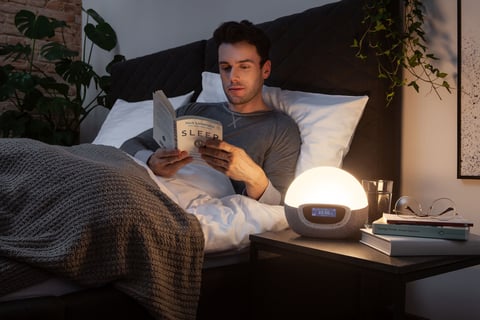Creating Your Optimal Sleep Environment: A Comprehensive Guide
In today's fast-paced world, the importance of quality sleep cannot be overstated. An optimal sleep environment is crucial for ensuring restorative rest and maintaining overall health. This guide will explore evidence-based strategies to transform your bedroom into a sleep sanctuary, addressing common concerns and providing practical solutions.


1. Temperature Control: he Foundation of Comfort
Extensive research in sleep science has consistently demonstrated that the optimal bedroom temperature for quality sleep falls within a specific range of 60-67°F (15-19°C). This temperature window is not arbitrary; it is carefully calibrated to support the body's natural physiological processes during sleep. As we prepare for rest, our core body temperature naturally begins to decrease, signaling to our brain that it's time to sleep. An environment within this temperature range facilitates this process, making it easier to fall asleep and maintain deeper, more restorative sleep stages throughout the night.
Moreover, this ideal temperature range helps to prevent common sleep disturbances. Rooms that are too warm can lead to restlessness, increased sweating, and more frequent awakenings, while overly cool rooms may cause discomfort and difficulty falling asleep. By maintaining a bedroom temperature within the 60-67°F range, you create an environment that works in harmony with your body's natural sleep-wake cycle, known as the circadian rhythm. This synergy between your body's internal processes and the external environment is key to achieving consistently high-quality sleep.
Install a programmable thermostat to maintain consistent temperatures throughout the night.
Use breathable bedding materials like cotton or bamboo to regulate body temperature.
Consider a cooling mattress or mattress topper for hot sleepers.
Use a fan or air conditioning to circulate air and maintain optimal temperature.
Wear breathable, lightweight sleepwear made from natural fibers.
Place a hot water bottle or heating pad at the foot of the bed to warm feet without overheating the body.
Consider using temperature-regulating bedding materials like phase-change fabrics.
2. Light Management: Syncing with Your Circadian Rhythm
Light exposure plays a crucial role in regulating our sleep-wake cycle, known as the circadian rhythm. This internal biological clock is highly sensitive to light, particularly blue light, which can suppress the production of melatonin, the hormone responsible for inducing sleep. Properly managing light exposure in your bedroom environment can significantly improve sleep quality and duration.
During the day, exposure to natural sunlight helps to reinforce your circadian rhythm, promoting alertness and energy. However, as evening approaches, it's essential to create a dimmer environment to signal to your body that it's time to prepare for sleep. This gradual transition from light to dark mimics the natural patterns our bodies evolved with, optimizing our sleep-wake cycle.
In the bedroom specifically, controlling light levels is paramount. Even small amounts of light from electronic devices, street lamps, or early morning sunlight can disrupt sleep patterns. By implementing effective light management strategies, you can create an ideal sleep sanctuary that supports your body's natural rhythms, leading to more restful and rejuvenating sleep.
Invest in blackout curtains or shades to eliminate external light sources.
Use dim, warm-toned lighting in the evening to promote melatonin production.
Avoid blue light from electronic devices at least 1-2 hours before bedtime.
Use smart light bulbs that can be programmed to gradually dim in the evening
Install light-filtering window films to reduce external light pollution
Place red or amber night lights in hallways or bathrooms for nighttime navigation
Consider using light therapy lamps in the morning to help regulate your circadian rhythm
3. Sound Optimization: Crafting a Serene Bedroom Sanctuary
The impact of noise on sleep quality cannot be overstated. Unwanted sounds, whether intermittent or constant, can significantly disrupt our sleep patterns, leading to fragmented sleep, increased awakenings, and overall reduced sleep quality. Even when we don't fully wake up, noise can cause shifts in sleep stages, preventing us from reaching or maintaining the deeper, more restorative phases of sleep that are crucial for physical and mental recovery.
The human brain continues to process auditory signals during sleep, making us vulnerable to environmental sounds. This evolutionary trait, while once crucial for survival, can now pose challenges in our modern, often noisy environments. Sudden noises can trigger the release of stress hormones, elevating heart rate and blood pressure, which can have long-term health implications if sleep is consistently disturbed.
Implementing effective sound management strategies is therefore essential in creating a peaceful sleep environment. This goes beyond simply reducing noise; it involves creating an acoustic atmosphere conducive to relaxation and uninterrupted sleep. By addressing noise issues, we can significantly improve not only the duration but also the quality of our sleep, leading to better overall health, increased daytime alertness, and improved cognitive function.
Use white noise machines or apps to mask disruptive sounds.
Consider soundproofing options like weatherstripping doors or using sound-absorbing curtains.
Opt for earplugs or noise-cancelling headphones if external noise persists.
Install acoustic panels or foam to absorb sound reflections in the room
Use heavy, sound-dampening curtains or drapes on windows
Place draft stoppers or door sweeps at the bottom of doors to block noise
Consider using a white noise app with nature sounds or calming music
4. Bedding Selection: The Foundation for Ideal Sleep Environment Support
Your choice of mattress and bedding is paramount in creating an optimal sleep environment. These elements play a crucial role in maintaining proper spinal alignment, regulating body temperature, and ensuring overall comfort throughout the night. A well-chosen mattress provides the necessary support to keep your spine in a neutral position, reducing the risk of back pain and promoting better sleep posture. This support is essential for all sleep positions, whether you're a side, back, or stomach sleeper.
Additionally, the right bedding materials contribute significantly to temperature regulation. High-quality, breathable fabrics like cotton, bamboo, or moisture-wicking synthetics can help manage body heat and moisture, preventing overheating and night sweats. This temperature control is crucial because our body temperature naturally fluctuates during sleep cycles, and maintaining an optimal sleep temperature is key to uninterrupted, restorative sleep.
Moreover, the texture and feel of your bedding can have a psychological impact on your sleep quality. Soft, comfortable sheets and pillows can create a sense of luxury and relaxation, helping to ease you into sleep more quickly and deeply. By investing in the right mattress and bedding, you're not just buying sleep accessories; you're creating a personalized sleep sanctuary that caters to your unique needs and preferences, ultimately leading to improved sleep quality and better overall health.
Choose a mattress that suits your preferred sleeping position and body type.
Select pillows that provide adequate neck support based on your sleep position.
Opt for breathable, hypoallergenic bedding materials to reduce allergens and regulate temperature.
Consider using a mattress topper for added comfort and customization
Invest in high-quality, moisture-wicking sheets for better temperature regulation
Rotate or flip your mattress regularly to ensure even wear and consistent support
Use a mattress protector to guard against allergens, dust mites, and spills
5. Air Quality: Enhancing Your Sleep Environment by Breathing Easy
The quality of air in your bedroom plays a crucial role in determining both your sleep quality and overall health. Breathing clean, fresh air throughout the night can significantly enhance your sleep experience and contribute to better physical and mental well-being. Poor air quality, on the other hand, can lead to various sleep disturbances and health issues.
Airborne particles, allergens, and pollutants can accumulate in enclosed spaces like bedrooms, potentially triggering allergies, asthma symptoms, or other respiratory problems. These issues can disrupt your sleep cycle, causing frequent awakenings, snoring, or difficulty breathing. Moreover, high levels of carbon dioxide from poor ventilation can lead to grogginess, headaches, and reduced cognitive function upon waking.
By maintaining good air quality in your bedroom, you create an environment that promotes deeper, more restorative sleep. Clean air supports your body's natural healing and regenerative processes that occur during sleep, potentially boosting your immune system and improving overall health outcomes. Additionally, a well-ventilated room with optimal humidity levels can enhance your comfort, making it easier to fall asleep and stay asleep throughout the night.
Ensure proper ventilation by opening windows regularly or using an air purifier with a HEPA filter.
Incorporate air-purifying plants like snake plants or peace lilies in your bedroom.
Maintain a clean bedroom by regularly washing bedding and vacuuming to reduce allergens.
Use a dehumidifier to maintain optimal humidity levels (between 30-50%) for better air quality and comfort.
Regularly clean or replace air conditioning and heating system filters to reduce airborne particles.
Consider using hypoallergenic bedding materials to minimize allergens in your sleep environment.
Keep pets out of the bedroom to reduce pet dander and improve air quality.
Frequently Asked Questions (FAQs)
Q: How does room temperature affect sleep quality?
A: Room temperature significantly impacts sleep quality. The ideal sleep temperature range is between 60-67°F (15-19°C). This cooler environment helps facilitate the natural drop in core body temperature that occurs during sleep, promoting faster sleep onset and deeper sleep stages. Temperatures outside this range can lead to restlessness, increased wakefulness, and reduced sleep quality.
Q: Can light exposure at night really impact my sleep?
A: Yes, light exposure, especially blue light from electronic devices, can significantly impact your sleep. Light suppresses the production of melatonin, the hormone responsible for regulating sleep-wake cycles. Exposure to bright or blue light in the evening can delay sleep onset and reduce overall sleep quality. It's recommended to limit exposure to bright lights and electronic devices at least 1-2 hours before bedtime.
Q: How often should I replace my mattress for optimal sleep?
A: On average, mattresses should be replaced every 6-8 years. However, this can vary depending on the quality of the mattress, your body weight, and how well you maintain it. Signs that it's time to replace your mattress include visible sagging, noticeable lumps, increased allergies, and waking up with aches and pains. Regularly rotating your mattress and using a mattress protector can help extend its lifespan.
Q: Are white noise machines effective for improving sleep?
A: White noise machines can be effective for many people in improving sleep quality. They work by creating a consistent background sound that can mask disruptive noises, making it easier to fall asleep and stay asleep. White noise has been shown to improve sleep onset latency (the time it takes to fall asleep) and promote more stable sleep patterns. However, individual responses to white noise can vary, so it's worth experimenting to see if it works for you.
Q: How can I improve air quality in my bedroom for better sleep?
A: Improving air quality in your bedroom can significantly enhance sleep quality. Here are some effective strategies:
Use an air purifier with a HEPA filter to remove allergens and pollutants.
Open windows regularly to allow fresh air circulation.
Keep indoor plants known for their air-purifying properties, such as spider plants or peace lilies.
Vacuum and dust regularly to reduce allergens.
Wash bedding weekly in hot water to eliminate dust mites.
Avoid using harsh chemical cleaners in the bedroom.
Consider using a dehumidifier if you live in a humid climate to prevent mold growth.
Video
Conclusion
By implementing these evidence-based strategies and addressing common concerns, you can create an optimal sleep environment tailored to your needs. Remember, good sleep is essential for overall health and well-being, and investing in your sleep environment is an investment in your quality of life.
As sleep science continues to evolve, stay informed about the latest research and recommendations from reputable sources such as the National Sleep Foundation and the American Academy of Sleep Medicine. Consult with a sleep specialist if you continue to experience persistent sleep issues despite optimizing your sleep environment.














Discover tips for sleep, detox, and mindfulness.
© 2024. All rights reserved.
